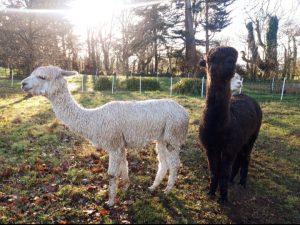We are delighted to welcome four new alpacas, Megastar, Marmalade, Senan and Walter, to the growing farm at Farmleigh.
Alpacas are ruminants, originating from South America, mainly from Peru, Bolivia and Chile, where they tend to live high in the Andes. They are social herd animals of the Camelid Family, closely related to llamas but noticeably smaller. They have been domesticated for over 6000 years. There are no wild alpacas. A Vicuña is a smaller, wild version of the alpaca.
Alpaca wool is referred to as a fibre because it has a hollow structure. This allows it to keep the alpaca hot in winter and cool in the summer. The alpaca fire is soft, yet strong and durable. It is water repellent, keeping the alpaca dry in inclement weather. It is lighter then sheep’s wool but much warmer and is flame resistant, making it advantageous for use in garments.
There are two breeds of alpacas, Suri and Huacaya. The main difference is in their fibre. Around 90% of alpacas are Huacaya, with a thicker spongy fleece that grows out from their bodies. This fleece is more conducive to surviving at high altitudes of the Andes. Around 10% of alpacas are Suri, which can be identified by their curly, silky fibre that grows down from their body. They are more likely to be found at lower altitudes where weather conditions are not so harsh, and the warmer fleece is not required
What is the difference between a llama and an alpaca?
Llamas are bigger and taller than alpacas. The llama can grow to 6 or 7 foot tall while the alpaca tends to be about 4 foot in height. Llamas weigh up to 250kg while the alpaca usually weighs no more than 95kg. The alpacas face is short and cute, with pointed ears, and generally has a calmer temperament to the llama, which has a more elongated face and ears, and may spit when grumpy.
Alpacas have softer finer fibre than llamas, which have two coats of fibre, a longer coarser outer layer and then a finer inner coat underneath. In South America the llama is bred as a pack animal and used to carry heavy loads high in the mountains. Alpacas are bred for their fibre as well as their meat and, believe it or not, it’s not just the fibre that is prized, their excrement is highly valued as an excellent fertiliser.
A huge thanks to K2 Alpacas for making sure Megastar, Marmalade, Senan and Walter settled in to their new home at Farmleigh.




